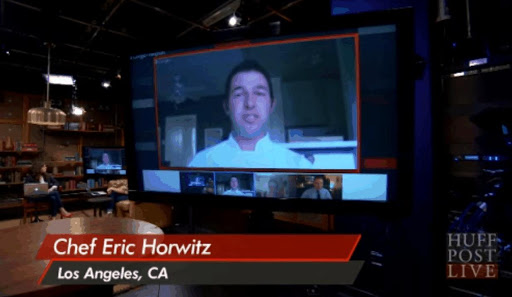
As a chef, school lunch programs are a hot-button topic as policies move our nutrition standards forward, but with some troubles.
This post is a lookback on some interesting points from my conversation with Huffington Post Live.
I was part of a panel in 2014 to provide different viewpoints on school lunch programs.
Each panelist chose an article to discuss and mine was Healthier School Meals Despite Agribiz Lobbying: Click Here to View
In a nutshell, the Healthy Hunger-Free Kids Act (HFFKA) that was passed by President Obama in 2010 was a reauthorization of funding for the original Child Nutrition Act with some good and bad changes.
The goal was to ensure kids had access to nutritious meals. The National School Lunch Program provides meals to 31 million kids, which can provide a third of their total daily calorie intake.
With all these kids relying on school lunches, it’s important that these meals be nutritious and filling. After all, 1 in 3 kids in the US are obese, a frightening statistic.
Good Stuff from HHFKA
- Grains must contain 50% whole grain.
- No trans fats are allowed
- Mandates that more fruits and vegetables must be present in meals, including leafy greens once a week
- Calorie maximums were set
Bad Stuff from HHFKA
- Flavored milk has to be nonfat or 1% but can still be LOADED with sugar. I.e. an 8-oz serving of chocolate milk has 22 grams of sugar…which is about the same amount of sugar in a half a 12-oz can of Coca-cola. Sugar spikes a child’s energy with a quick dip afterward, which leads to less focus and energy in the classroom. More info here
- Pizza Industry still has a lot of influence. They can count a “vegetable” as “tomato paste” even if only a few tablespoons are used on a slice of pizza that’s mostly carbs and high-fat cheese.
- French Fry Manufacturers were still able to include frozen french fries into meal plans
The Conversation
The roundtable discussion on Huffington Post Live was interesting and informative. Unfortunately the link for it is gone but we discussed the effects the lunch program was having on schools, warts and all.
Some interesting points were brought up about how it was an imperfect step forward.
HHFKA granted $4.5 billion for implementing these new standards to schools for 10 years.
Problems still came up such as that some students threw away a lot of food and other students according to a Harvard study.
Student also complained about the portion size shrinking due to lower budgets and stricter standards. They would take a picture of a small lunch and post it on social media with #Thanksmichelleobama used in a sarcastic way.
Besides not always wanting to eat vegetables, kids are the target of $2 billion in a year in advertising dollars to market unhealthy products to kids.
There’s a lot more to discuss and if learning about the latest policies when it comes to food, nutrition and school lunches is something you find interesting, let me know and I’ll do some more newsletters on the topic.
Best,
Chef Eric
P.S. School is back and HEALTHY cooking after-school programs are open, you can signup here before all our spots are filled.